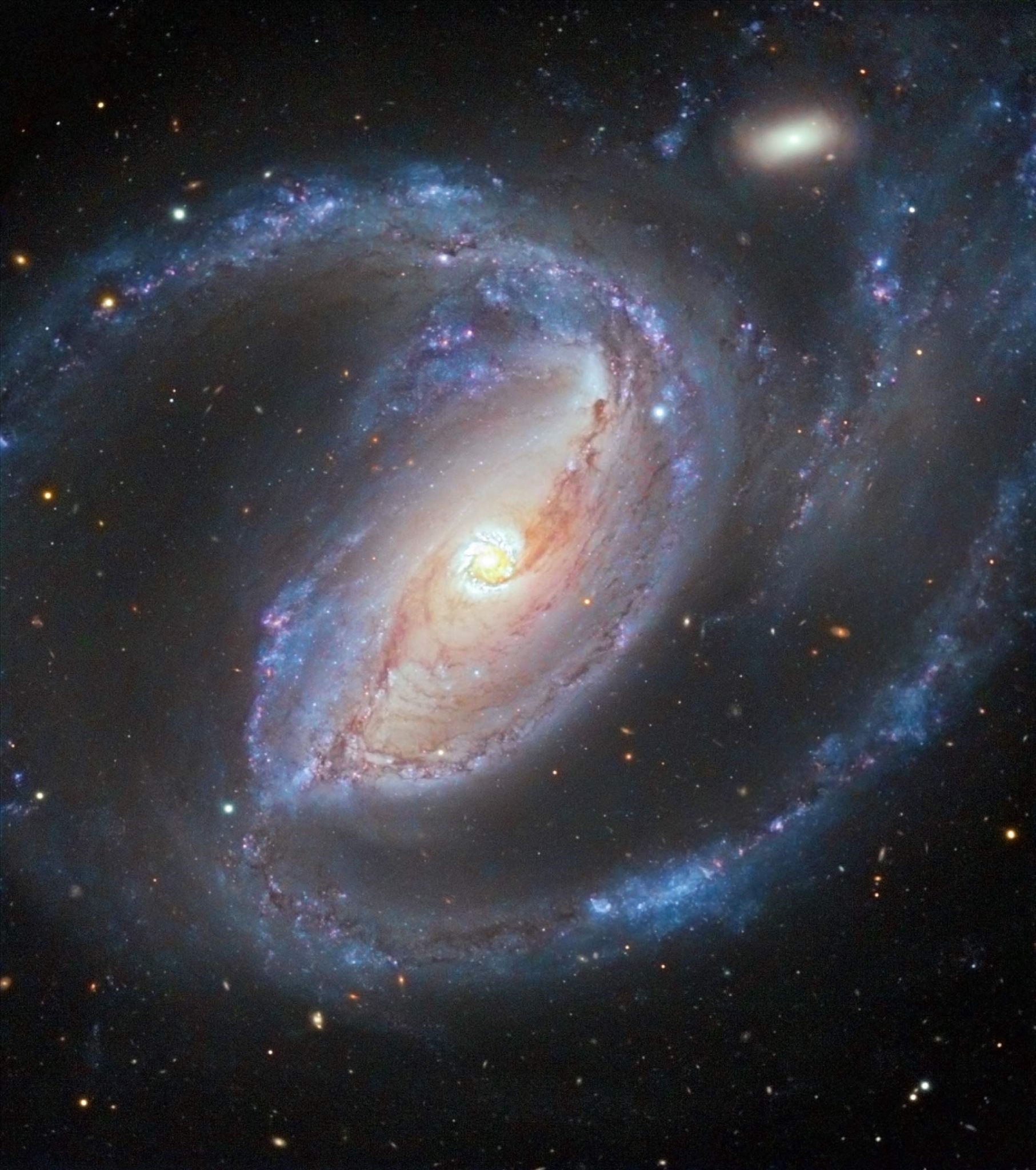Blog
NGC 1097 (also known as Caldwell 67) is a barred spiral galaxy about 45 million light years away in the constellation Fornax. It was discovered by William Herschel on 9 October 1790. It is a severely interacting galaxy with obvious tidal debris and distortions caused by interaction with the companion galaxy NGC 1097A.
Four supernovae have been observed in NGC 1097: SN 1992bd (type II, mag. 15), SN 1999eu (type II-pec, mag. 19.7), SN 2003B (type II, mag. 17.6), and SN 2023rve (type II, mag. 14). NGC 1097 is also a Seyfert galaxy. Deep photographs revealed four narrow optical jets that appear to emanate from the nucleus.

more...
Richard Christopher Wakeman CBE (born 18 May 1949) is an English keyboardist and composer best known as a member of the progressive rock band Yes across five tenures between 1971 and 2004, and for his prolific solo career. AllMusic describes Wakeman as a “classically trained keyboardist extraordinaire who plied his trade with Yes and developed his own brand of live spectacular in a solo act.”
Born and raised in West London, Wakeman quit his studies at the Royal College of Music in 1969 to become a full-time session musician. His early sessions included “Space Oddity“, among other tracks, for David Bowie, and songs by Elton John, Marc Bolan, Cat Stevens, and Lou Reed. In 1970, Wakeman joined the folk rock group the Strawbs, during which his virtuosity gained national press coverage. He left in 1971 to join Yes, with whom he played on some of their most influential albums across two stints until 1980. During this time Wakeman began a solo career in 1973 and became an iconic and prominent figure in progressive rock. His highest-selling and most acclaimed albums are his first three: The Six Wives of Henry VIII (1973), the UK number-one Journey to the Centre of the Earth (1974), and The Myths and Legends of King Arthur and the Knights of the Round Table (1975), all concept albums. In 1974, he formed his band the English Rock Ensemble, with which he toured worldwide and continues to perform, and went on to score his first major film, Lisztomania (1975).
more...Kai Chresten Winding May 18, 1922 – May 6, 1983) was a Danish-born American trombonist and jazz composer. He is known for his collaborations with fellow trombonist J. J. Johnson. His version of “More“, the theme from the movie Mondo Cane, reached in 1963 number 8 in the Billboard Hot 100 and remained his only entry here.
more...Joseph Vernon “Big Joe” Turner Jr. (May 18, 1911 – November 24, 1985) was an American blues shouter from Kansas City, Missouri. According to songwriter Doc Pomus, “Rock and roll would have never happened without him”. Turner’s greatest fame was due to his rock and roll recordings in the 1950s, particularly “Shake, Rattle and Roll“, but his career as a performer endured from the 1920s into the 1980s.
Turner was inducted into the Rock and Roll Hall of Fame in 1987, with the Hall lauding him as “the brawny voiced ‘Boss of the Blues'”. AllMusic called Turner “the premier blues shouter of the postwar era”.
Turner was born May 18, 1911, in Kansas City, Missouri, United States. His father was killed in a train accident when Turner was four years old. He sang in his church, and on street corners for money. He left school at age fourteen to work in Kansas City’s nightclubs, first as a cook and later as a singing bartender. He became known as “The Singing Barman”, and worked in such venues as the Kingfish Club and the Sunset, and would frequently perform at these venues alongside his friend Pete Johnson on piano. The Sunset was managed by Piney Brown. It featured “separate but equal” facilities for white patrons. Turner wrote “Piney Brown Blues” in his honor and sang it throughout his career.
more...Friday May 17th 2024 630pm. This service includes musician Tzachi Buchnik, who lives in our partnership region in Israel. He lives in the Golan Heights, works at the Jordan Valley Regional Council, and is the father of three sons.
Music with Jennifer Strauss-Klein, Tami Morse, Adam Dorn, Neil Seal, Julie Kogan White, Brian Deyoung and mick LaBriola.
more...This well-composed composite panoramic view looks due south from Banks Peninsula near Christchurch on New Zealand’s South Island. The base of a tower-like rocky sea stack is awash in the foreground, with stars of the Southern Cross at the top of the frame and planet Earth’s south celestial pole near center. Still, captured on May 11, vibrant aurora australis dominate the starry southern sea and skyscape. The shimmering southern lights were part of extensive auroral displays that entertained skywatchers in northern and southern hemispheres around planet Earth, caused by intense geomagnetic storms. The extreme spaceweather was triggered by the impact of coronal mass ejections launched from powerful solar active region AR 3664.

William Scott Bruford (born 17 May 1949) is an English former drummer and percussionist who first gained prominence as a founding member of the progressive rock band Yes. After leaving Yes in 1972, Bruford spent the rest of the 1970s recording and touring with King Crimson (1972–1974), Roy Harper (1975), and U.K. (1978), as well as touring with Genesis (1976). In 1978, he formed his own group, Bruford, which was active until 1980.
During the 1980s, Bruford returned to King Crimson for three years (1981–1984), collaborated with several artists (including Patrick Moraz and David Torn), and formed his own electric jazz band Earthworks in 1986. He then played with his former Yes bandmates in Anderson Bruford Wakeman Howe, which eventually led to a very brief second stint in Yes. Bruford played in King Crimson for his third and final tenure from 1994 to 1997, then continued with a new acoustic configuration of Earthworks.
On 1 January 2009, Bruford retired from professional drumming, only briefly returning for a few private gigs. He has pursued other projects since then, including the operation of his two record labels, Summerfold and Winterfold, releasing an autobiography in 2009, and speaking and writing about music. In 2016, after four and a half years of study, Bruford received a PhD in Music from the University of Surrey. That year, Bruford ranked No. 16 on Rolling Stone‘s list of the “100 Greatest Drummers of All Time”. In 2017, Bruford was inducted into the Rock and Roll Hall of Fame as a member of Yes.
more...Henry St. Claire Fredericks Jr. (born May 17, 1942), better known by his stage name Taj Mahal, is an American blues musician. He plays the guitar, piano, banjo, harmonica, and many other instruments,often incorporating elements of world music into his work. Mahal has done much to reshape the definition and scope of blues music over the course of his more than 50-year career by fusing it with nontraditional forms, including sounds from the Caribbean, Africa, India, Hawaii, and the South Pacific.
Mahal was born Henry St. Claire Fredericks Jr. on May 17, 1942, in Harlem, New York City. Growing up in Springfield, Massachusetts, he was raised in a musical environment: his mother was a member of a local gospel choir and his father, Henry Saint Claire Fredericks Sr., was an Afro-Caribbean jazz arranger and piano player. His family owned a shortwave radio which received music broadcasts from around the world, exposing him at an early age to world music. Early in childhood he recognized the stark differences between the popular music of his day and the music that was played in his home. He also became interested in jazz, enjoying the works of musicians such as Charles Mingus, Thelonious Monk and Milt Jackson. His parents came of age during the Harlem Renaissance, instilling in their son a sense of pride in his Caribbean and African ancestry through their stories.
Because his father was a musician, his home frequently hosted other musicians from the Caribbean, Africa, and the US. His father was called “The Genius” by Ella Fitzgerald before starting his family.Early on, Henry Jr. developed an interest in African music, which he studied assiduously as a young man. His parents encouraged him to pursue music, starting him out with classical piano lessons. He also studied the clarinet, trombone and harmonica.
more...John Lenwood McLean (May 17, 1931 – March 31, 2006) was an American jazz alto saxophonist, composer, bandleader, and educator, and is one of the few musicians to be elected to the DownBeat Hall of Fame in the year of their death.
McLean was born in New York City. His father, John Sr., played guitar in Tiny Bradshaw‘s orchestra. After his father’s death in 1939, Jackie’s musical education was continued by his godfather, his record-store-owning stepfather, and several noted teachers. He also received informal tutoring from neighbors Thelonious Monk, Bud Powell, and Charlie Parker. During high school McLean played in a band with Kenny Drew, Sonny Rollins, and Andy Kirk, Jr. (the saxophonist son of Andy Kirk).
Along with Rollins, McLean played on Miles Davis‘ Dig album, when he was 20 years old. As a young man he also recorded with Gene Ammons, Charles Mingus (for Pithecanthropus Erectus), George Wallington, and as a member of Art Blakey‘s Jazz Messengers. McLean joined Blakey after reportedly being punched by Mingus. Fearing for his life, McLean pulled out a knife and contemplated using it against Mingus in self-defense, but later stated that he was grateful that he had not stabbed the bassist.
more...Walter Dewey Redman (May 17, 1931 – September 2, 2006) was an American saxophonist who performed free jazz as a bandleader and with Ornette Coleman and Keith Jarrett.
Redman mainly played tenor saxophone, though he occasionally also played alto, the Chinese suona(which he called a musette), and clarinet. His son is saxophonist Joshua Redman.
Redman was born in Fort Worth, Texas. He attended I.M. Terrell High School, and played in the school band with Ornette Coleman, Prince Lasha, and Charles Moffett. After high school, he briefly enrolled in the electrical engineering program at the Tuskegee Institute in Alabama but became disillusioned with the program and returned home to Texas. In 1953, he earned a bachelor’s degree in Industrial Arts from Prairie View Agricultural and Mechanical University. While at Prairie View, he switched from clarinet to alto saxophone, then to tenor. After graduating, he served for two years in the U. S. Army.
After his discharge from the Army, Redman began working on a master’s degree in education at the University of North Texas. While working on his degree, he taught music to fifth graders in Bastrop, Texasand worked as a freelance saxophonist at night and weekends in Austin, Texas. In 1957, he graduated in Education with a minor in Industrial Arts. While at North Texas, he did not enroll in any music classes.
In 1959 he moved to San Francisco, resulting in a collaboration with clarinettist Donald Garrett.
Redman was best known for his 1968-1972 collaboration with saxophonist Ornette Coleman, with whom he had performed in his Fort Worth high school marching band. He also played in pianist Keith Jarrett‘s American Quartet (1971–1976). Jarrett’s The Survivors’ Suite was voted Jazz Album of the Year by Melody Maker in 1978. In the 1970s Redman formed the quartet Old and New Dreams with Don Cherry, Charlie Haden, and Ed Blackwell. They recorded four albums in the period to 1987.
more...Alegria is a cante chico flamenco form that belongs to the Cantiñas family and originates in Andalusian the town of Cadíz. It is usually played at a lively rhythm (120-170 beats per minute) and in a major key. Alegria letras focus on light-hearted themes like love, humor, and happiness – the word “alegria” literally means “joy.”
The compas of alegria is based on a twelve count similar to solea and emphasizes the 3, 6, 8, 10, and 12 beats.
Alegria is structurally one of the strictest forms of flamenco. A traditional dance in alegria must contain each of the following sections, in order:
- salida (entrance)
- paseo (walkaround)
- silencio (similar to an adagio in ballet – it is the singer who is “silent”)
- castellana (upbeat section)
- escobilla (literally “brush” as with a broom, which describes dancers’ footwork in this section)
- bulerias
This structure is often not strictly followed when alegria is played as a standalone song with no dancing. You will, however, frequently hear parts of this structure in solo guitar playing. In this way an artist can pay homage to the entirety of the art form, even when a dancer is not present.
more...The Iris Nebula (also known as NGC 7023 and Caldwell 4) is a bright reflection nebula in the constellation Cepheus. The designation NGC 7023 refers to the open cluster within the larger reflection nebula designated LBN 487.
The nebula, which shines at magnitude +6.8, is illuminated by a magnitude +7.4 star designated HD 200775. It is located near the Mira-type variable star T Cephei, and near the bright magnitude +3.23 variable star Beta Cephei (Alfirk). It lies 1,300 light-years away and is six light-years across.

William Emanuel Cobham Jr. (born May 16, 1944) is a Panamanian–American jazz drummer who came to prominence in the late 1960s and early 1970s with trumpeter Miles Davis and then with the Mahavishnu Orchestra.
He was inducted into the Modern Drummer Hall of Fame in 1987 and the Classic Drummer Hall of Fame in 2013. AllMusic biographer Steve Huey said, “Generally acclaimed as fusion’s greatest drummer, Billy Cobham’s explosive technique powered some of the genre’s most important early recordings – including groundbreaking efforts by Miles Davis and the Mahavishnu Orchestra – before he became an accomplished bandleader in his own right. At his best, Cobham harnessed his amazing dexterity into thundering, high-octane hybrids of jazz complexity and rock & roll aggression.”
Cobham’s influence stretched far beyond jazz; he influenced progressive rock contemporaries like Bill Bruford of King Crimson, and later ones like Danny Carey of Tool. Prince and Jeff Beck both played a version of Cobham’s “Stratus” in concert. Phil Collins, who named the Mahavishnu Orchestra’s The Inner Mounting Flame as a key influence on his early style, said: “Billy Cobham played some of the finest drumming I’ve ever heard on that record.”
Born in Colón, Panama, Cobham moved with his family to Brooklyn, New York, when he was three. His father, Manuel, worked as a hospital statistician during the week and played piano on weekends. Cobham started playing drums at the age of four, and joined his father four years later. When he was fourteen, he got his first drum kit as a gift after being accepted to The High School of Music & Art in New York City. He was drafted in 1965, and for the next three years he played with a U.S. Army band.
more...Betty Carter (born Lillie Mae Jones; May 16, 1929 – September 26, 1998) was an American jazz singer known for her improvisational technique, scatting and other complex musical abilities that demonstrated her vocal talent and imaginative interpretation of lyrics and melodies. Vocalist Carmen McRae once remarked: “There’s really only one jazz singer—only one: Betty Carter.”
Carter was born in Flint, Michigan, and grew up in Detroit, where her father, James Jones, was the musical director of a Detroit church and her mother, Bessie, was a housewife. As a child, Carter was raised to be extremely independent and to not expect nurturing from her family.
more...More Posts
- World Music Vladimir Cauchemar & alyona alyona
- Daily Roots Fatman Riddim Section
- Cosmos IC 1848
- Phineas Newborn Jr.
- Leo Wright
- Cecil Payne
- Clark Terry
- World Music Ganger
- Daily Roots The Conquerors
- Cosmos Dark Horse & Rho Ophiuchi
- Lucky Peterson
- Majida el Roumi
- Ben Tucker
- Sonny Greer
- World Music Tellef Kvifte
- Daily Roots DEB Music Players
- Cosmos IC 1396
- Dickey Betts
- Alex Acuna
- Tony Williams


